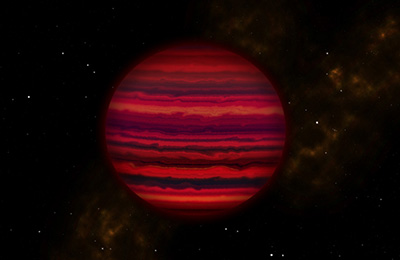
Artist’s rendering of WISE 0855 as it might appear if viewed up close in infrared light. (Illustration by Joy Pollard, Gemini Observatory/AURA)
Difficult spectroscopic observations reveal properties of the coldest known object outside of our solar system. Since its detection in 2014, the brown dwarf known as WISE 0855 has fascinated astronomers. Only 7.2 light-years from Earth, it is the coldest known object outside of our solar system and is just barely visible at infrared wavelengths with the largest ground-based telescopes.
Now, a team has succeeded in obtaining an infrared spectrum of WISE 0855 using the Gemini North telescope in Hawaii, providing the first details of the object’s composition and chemistry. Among the findings is strong evidence for the existence of clouds of water or water ice, the first such clouds detected outside of our solar system.
A brown dwarf is essentially a failed star, having formed the way stars do through the gravitational collapse of a cloud of gas and dust, but without gaining enough mass to spark the nuclear fusion reactions that make stars shine. With about 5X the mass of Jupiter, WISE 0855 resembles that gas giant planet in many respects. Its is ~250K, making it nearly as cold as Jupiter, which is 130K. “WISE 0855 is our first opportunity to study an extrasolar planetary-mass object that is nearly as cold as our own gas giants,” Skemer said.
WISE 0855 is too faint for conventional spectroscopy at optical or near-infrared wavelengths, but thermal emission from the deep atmosphere at wavelengths in a narrow window around 5 microns offered an opportunity where spectroscopy would be “challenging but not impossible,” he said. The team used the Gemini-North telescope in Hawaii and Gemini Near Infrared Spectrograph to observe WISE 0855 over 13 nights for a total of about 14 hours.
“It’s 5X fainter than any other object detected with ground-based spectroscopy at this wavelength,” Skemer said. “Our spectrum shows that WISE 0855 is dominated by water vapor and clouds, with an overall appearance that is strikingly similar to Jupiter.” The researchers developed atmospheric models of the equilibrium chemistry for a brown dwarf at 250K and calculated the resulting spectra under different assumptions, including cloudy and cloud-free models. The models predicted a spectrum dominated by features resulting from water vapor, and the cloudy model yielded the best fit to the features in the spectrum of WISE 0855.
Comparing the brown dwarf to Jupiter, the team found that their spectra are strikingly similar with respect to water absorption features. One significant difference is the abundance of phosphine in Jupiter’s atmosphere. Phosphine forms in the hot interior of the planet and reacts to form other compounds in the cooler outer atmosphere, so its appearance in the spectrum is evidence of turbulent mixing in Jupiter’s atmosphere. The absence of a strong phosphine signal in the spectrum of WISE 0855 implies that it has a less turbulent atmosphere. http://news.ucsc.edu/2016/07/coldest-brown-dwarf.html








Recent Comments